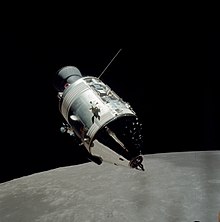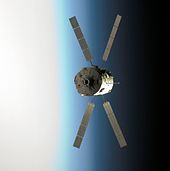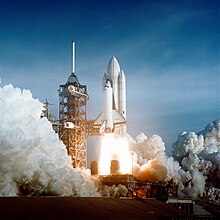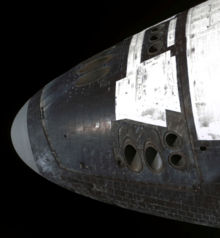Spacecraft

| Part of a series on |
| Spaceflight |
|---|
 |
|
|
A spacecraft (pl.: spacecraft) is a vehicle that is designed to
On a
Orbital spacecraft may be recoverable or not. Most are not. Recoverable spacecraft may be subdivided by a method of reentry to Earth into non-winged space capsules and winged spaceplanes. Recoverable spacecraft may be reusable (can be launched again or several times, like the SpaceX Dragon and the Space Shuttle orbiters) or expendable (like the Soyuz). In recent years, more space agencies are tending towards reusable spacecraft.
Humanity has achieved space flight, but
History

A German
While Sputnik 1 was the first spacecraft to orbit the Earth, other human-made objects had previously reached an altitude of 100 km, which is the height required by the international organization Fédération Aéronautique Internationale to count as a spaceflight. This altitude is called the Kármán line. In particular, in the 1940s there were several test launches of the V-2 rocket, some of which reached altitudes well over 100 km.
Crewed and uncrewed spacecraft
Crewed spacecraft

As of 2016, only three nations have flown crewed spacecraft: USSR/Russia, USA, and China. The first crewed spacecraft was
Other Soviet crewed spacecraft include the
Except for the Space Shuttle and the Buran spaceplane of the Soviet Union, the latter of which only ever had one uncrewed test flight, all of the recoverable crewed orbital spacecraft were space capsules.
- Crewed spacecraft
-
American Mercury, Gemini, and Apollo spacecraft
-
Soviet Vostok capsule
-
Soviet Voskhod (variant of Vostok)
-
1967 Soviet/Russian Soyuz spacecraft
-
Chinese Shenzhou spacecraft
The International Space Station, crewed since November 2000, is a joint venture between Russia, the United States, Canada and several other countries.
Uncrewed spacecraft


Uncrewed spacecraft are spacecraft without people on board. Uncrewed spacecraft may have varying levels of autonomy from human input; they may be
Many space missions are more suited to telerobotic rather than crewed operation, due to lower cost and lower risk factors. In addition, some planetary destinations such as Venus or the vicinity of Jupiter are too hostile for human survival. Outer planets such as Saturn, Uranus, and Neptune are too distant to reach with current crewed spaceflight technology, so telerobotic probes are the only way to explore them. Telerobotics also allows exploration of regions that are vulnerable to contamination by Earth micro-organisms since spacecraft can be sterilized. Humans can not be sterilized in the same way as a spaceship, as they coexist with numerous micro-organisms, and these micro-organisms are also hard to contain within a spaceship or spacesuit. Multiple space probes were sent to study Moon, the planets, the Sun, multiple small Solar System bodies (comets and asteroids).
Special class of uncrewed spacecraft is
Other
Some spacecraft can operate as both a crewed and uncrewed spacecraft. The Buran spaceplane, for example, could operate autonomously but also had manual controls, though it never flew with crew onboard.
Types of spacecraft
Communications satellite
A communications satellite is an
The high frequency
Cargo spacecraft

Cargo or resupply spacecraft are robotic spacecraft that are designed specifically to carry cargo, possibly to support space stations' operation by transporting food, propellant and other supplies.
Automated cargo spacecraft have been used since 1978 and have serviced Salyut 6, Salyut 7, Mir, the International Space Station and Tiangong space station.
As of 2023, three different cargo spacecraft are used to supply the International Space Station: Russian Progress, American SpaceX Dragon 2 and Cygnus. Chinese Tianzhou is used to supply Tiangong space station.
Space probes
Space probes are robotic spacecraft that are sent to explore deep space, or astronomical bodies other than Earth. They are distinguished from landers by the fact that they work in open space, not on planetary surfaces or in planetary atmospheres. Being robotic eliminates the need for expensive, heavy life support systems (the Apollo crewed Moon landings required the use of the Saturn V rocket that cost over a billion dollars per launch, adjusted for inflation) and so allows for lighter, less expensive rockets. Space probes have visited every planet in the Solar System and Pluto, and the Parker Solar Probe has an orbit that, at its closest point, is in the Sun's chromosphere. There are five space probes that are escaping the Solar System, these are Voyager 1, Voyager 2, Pioneer 10, Pioneer 11, and New Horizons.
Voyager program
The identical
Space telescopes
A space telescope or space observatory is a
Landers

A lander is a type of spacecraft that makes a soft landing on the surface of an
Space capsules
Space capsules are a type of spacecraft that can return from space at least once. They have a blunt shape, do not usually contain much more fuel than needed, and they do not possess wings unlike
Spaceplanes

Spaceplanes are spacecraft that are built in the shape of, and function as, airplanes. The first example of such was the North American X-15 spaceplane, which conducted two crewed flights which reached an altitude of over 100 kilometres (62 mi) in the 1960s. This first reusable spacecraft was air-launched on a suborbital trajectory on July 19, 1963.
The first reusable orbital spaceplane was the
The first autonomous reusable spaceplane was the
Per the
Scaled Composites' SpaceShipOne was a reusable suborbital spaceplane that carried pilots Mike Melvill and Brian Binnie on consecutive flights in 2004 to win the Ansari X Prize. The Spaceship Company built a successor SpaceShipTwo. A fleet of SpaceShipTwos operated by Virgin Galactic was planned to begin reusable private spaceflight carrying paying passengers in 2014, but was delayed after the crash of VSS Enterprise.
Space Shuttle

The Space Shuttle is a retired reusable Low Earth Orbital launch system. It consisted of two reusable Solid Rocket Boosters that landed by parachute, were recovered at sea, and were the most powerful rocket motors ever made until they were superseded by those of NASA’s SLS rocket, with a liftoff thrust of 2,800,000 pounds-force (12 MN), which soon increased to 3,300,000 pounds-force (15 MN) per booster,[19] and were fueled by a combination of PBAN and APCP, the Space Shuttle Orbiter, with 3 RS-25 engines that used a liquid oxygen/liquid hydrogen propellant combination, and the bright orange throwaway Space Shuttle external tank from which the RS-25 engines sourced their fuel. The orbiter was a spaceplane that was launched at NASA’s Kennedy Space Centre and landed mainly at the Shuttle Landing Facility, which is part of Kennedy Space Centre. A second launch site, Vandenberg Space Launch Complex 6 in California, was revamped so it could be used to launch the shuttles, but it was never used. The launch system could lift about 29 tonnes (64,000 lb) into an eastward Low Earth Orbit. Each orbiter weighed roughly 78 tonnes (172,000 lb), however the different orbiters had differing weights and thus payloads, with Columbia being the heaviest orbiter, Challenger being lighter than Columbia but still heavier than the other three. The orbiter structure was mostly composed of aluminium alloy. The orbiter had seven seats for crew members, though on STS-61-A the launch took place with 8 crew onboard. The orbiters had 4.6 metres (15 ft) wide by 18 metres (59 ft) long payload bays and also were equipped with a 15.2 metres (50 ft) CanadaArm1, an upgraded version of which is used on the International Space Station. The heat shield (or Thermal Protection System) of the orbiter, used to protect it from extreme levels of heat during atmospheric reentry and the cold of space, was made up of different materials depending on weight and how much heating a particular area on the shuttle would receive during reentry, which ranged from over 2,900 °F (1,600 °C) to under 700 °F (370 °C). The orbiter was manually operated, though an autonomous landing system was added while the shuttle was still on service. It had an in orbit maneouvreing system known as the Orbital Manoeuvring System, which used the hypergolic propellants monomethylhydrazine (MMH) and dinitrogen tetroxide, which was used for orbital insertion, changes to orbits and the deorbit burn.

Though the shuttle’s goals were to drastically decrease launch costs, it did not do so, ending up being much more expensive than similar expendable launchers. This was due to expensive refurbishment costs and the external tank being expended. Once a landing had occurred, the SRBs and many parts of the orbiter had to be disassembled for inspection, which was long and arduous. Furthermore, the RS-25 engines had to be replaced every few flights. Each of the heat shielding tiles had to go in one specific area on the orbiter, increasing complexity more. Adding to this, the shuttle was a rather dangerous system, with fragile heat shielding tiles, some being so fragile that one could easily scrape it off by hand, often having been damaged in many flights. After 30 years in service from 1981 to 2011 and 135 flights, the shuttle was retired from service due to the cost of maintaining the shuttles, and the 3 remaining orbiters (the other two were destroyed in accidents) were prepared to be displayed in museums.
Other
Some spacecraft do not fit particularly well into any of the general spacecraft categories. This is a list of these spacecraft.
SpaceX Starship
Starship is a spacecraft and
Mission Extension Vehicle
The Mission Extension Vehicle is a robotic spacecraft designed to prolong the life on another spacecraft. It works by docking to its target spacecraft, then correcting its orientation or orbit. This also allows it to rescue a satellite which is in the wrong orbit by using its own fuel to move its target to the correct orbit. The project is currently managed by Northrop Grumman Innovation Systems. As of 2023, 2 have been launched. The first launched on a Proton rocket on 9 October 2019, and did a rendezvous with Intelsat-901 on 25 February 2020. It will remain with the satellite until 2025 before the satellite is moved to a final graveyard orbit and the vehicle does a rendezvous with another satellite. The other one launched on an Ariane 5 rocket on 15 August 2020.
Subsystems
This section may need to be rewritten to comply with Wikipedia's quality standards. (November 2022) |
A spacecraft
- Life support
- Spacecraft intended for human spaceflight must also include a life support systemfor the crew.

- Attitude control
- A spacecraft needs an attitude control subsystem to be correctly oriented in space and respond to external torques and forces properly. This may use reaction wheels or it may use small rocket thrusters. The altitude control subsystem consists of sensors and actuators, together with controlling algorithms. The attitude-control subsystem permits proper pointing for the science objective, sun pointing for power to the solar arrays and earth pointing for communications.
- GNC
- Guidance refers to the calculation of the commands (usually done by the CDH subsystem) needed to steer the spacecraft where it is desired to be. Navigation means determining a spacecraft's orbital elements or position. Control means adjusting the path of the spacecraft to meet mission requirements.
- Command and data handling
- The C&DH subsystem receives commands from the communications subsystem, performs validation and decoding of the commands, and distributes the commands to the appropriate spacecraft subsystems and components. The CDH also receives housekeeping data and science data from the other spacecraft subsystems and components, and packages the data for storage on a data recorderor transmission to the ground via the communications subsystem. Other functions of the CDH include maintaining the spacecraft clock and state-of-health monitoring.
- Communications
- Spacecraft, both receiver/retransmitterelectronic technologies.
- Power
- Spacecraft need an electrical power generation and distribution subsystem for powering the various spacecraft subsystems. For spacecraft near the eclipsedby Earth.
- Thermal control
- Spacecraft must be engineered to withstand transit through actuatorssuch as louvers to control temperature ranges of equipments within specific ranges.
- Spacecraft propulsion
- Spacecraft may or may not have a inclination adjustment maneuvers. A propulsion system is also needed for spacecraft that perform momentum management maneuvers. Components of a conventional propulsion subsystem include fuel, tankage, valves, pipes, and thrusters. The thermal control system interfaces with the propulsion subsystem by monitoring the temperature of those components, and by preheating tanks and thrusters in preparation for a spacecraft maneuver.
- Structures
- Spacecraft must be engineered to withstand launch loads imparted by the launch vehicle, and must have a point of attachment for all the other subsystems. Depending on mission profile, the structural subsystem might need to withstand loads imparted by entry into the atmosphere of another planetary body, and landing on the surface of another planetary body.
- Payload
- The payload depends on the mission of the spacecraft, and is typically regarded as the part of the spacecraft "that pays the bills". Typical payloads could include scientific instruments (cameras, telescopes, or particle detectors, for example), cargo, or a human crew.
- Ground segment
- The ground stations to radiate signals to and receive signals from the spacecraft, and a voice and data communications network to connect all mission elements.[23]
- Launch vehicle
- The reusable. In a single stage to orbitrocket, the rocket can be considered a spacecraft itself.
Spacecraft records
Fastest spacecraft
- Parker Solar Probe (estimated 343,000 km/h or 213,000 mph at first sun close pass, will reach 700,000 km/h or 430,000 mph at final perihelion)[24]
- HeliosI and II Solar Probes (252,792 km/h or 157,078 mph)
Furthest spacecraft from the Sun
- Voyager 1 at 156.13 AU as of April 2022, traveling outward at about 3.58 AU/a (61,100 km/h; 38,000 mph)[25]
- Pioneer 10 at 122.48 AU as of December 2018, traveling outward at about 2.52 AU/a (43,000 km/h; 26,700 mph)[25]
- Voyager 2 at 122.82 AU as of January 2020, traveling outward at about 3.24 AU/a (55,300 km/h; 34,400 mph)[25]
- Pioneer 11 at 101.17 AU as of December 2018, traveling outward at about 2.37 AU/a (40,400 km/h; 25,100 mph)[25]
See also
- Astrionics
- Commercial astronaut
- Flying saucer
- List of crewed spacecraft
- List of fictional spacecraft
- NewSpace
- Spacecraft design
- Space exploration
- Space launch
- Spaceships in science fiction
- Space suit
- Spaceflight records
- Starship
- Timeline of Solar System exploration
- U.S. Space Exploration History on U.S. Stamps
Notes
References
Citations
- ^ Adams, Sam (29 August 2016). "Taiwanese navy fires NUCLEAR MISSILE at fisherman during horrifying accident". Daily Mirror.
- ^ "At Mach-10, Taiwan's Hsiung Feng-III 'Anti-China' Missiles could be faster than the BrahMos". defencenews.in. Archived from the original on 7 August 2017. Retrieved 8 January 2019.
- ^ Villasanta, Arthur Dominic (21 October 2016). "Taiwan Extending the Range of its Hsiung Feng III Missiles to Reach China".
- ^ Elias, Jibu (10 April 2018). "TSMC set to beat Intel to become the world's most advanced chipmaker". PCMag India. Archived from the original on 12 May 2019. Retrieved 12 May 2019.
- ^ "TSMC is about to become the world's most advanced chipmaker". The Economist. 5 April 2018.
- ^ "Taiwan's upgraded 'Cloud Peak' mi... – Taiwan News". Taiwan News. 25 January 2018.
- ^ "Taiwan To Upgrade 'Cloud Peak' Medium-range Missiles For Micro-Satellites Launch". www.defenseworld.net.
- ^ Sheldon, John (30 January 2018). "Taiwan's New Ballistic Missile Capable of Launching Microsatellites – SpaceWatch.Global". spacewatch.global.
- ISBN 3-8118-4341-9.
- ^ Garcia, Mark, ed. (4 October 2017). "60 years ago, the Space Age began". NASA. Archived from the original on 22 January 2023. Retrieved 1 September 2023.
- ^ Swenson, L. Jr.; Grimwood, J. M.; Alexander, C. C. This New Ocean, A History of Project Mercury. pp. 66–62424.
On October 4, 1957 Sputnik I shot into orbit and forcibly opened the Space Age.
- ^ "Vostok". Encyclopedia Astronautica. Archived from the original on 29 June 2011.
- ^ Labrador, Virgil (19 February 2015). "satellite communication". Britannica.com. Retrieved 10 February 2016.
- ^ "Satellites - Communication Satellites". Satellites.spacesim.org. Retrieved 10 February 2016.
- ^ "Military Satellite Communications Fundamentals | The Aerospace Corporation". Aerospace. 1 April 2010. Archived from the original on 5 September 2015. Retrieved 10 February 2016.
- ^ "Voyager 1 - NASA Science". science.nasa.gov. Retrieved 22 November 2023.
- ^ "Mission Status".
- ^ @SpaceX (30 May 2020). "Liftoff!" (Tweet). Retrieved 31 May 2020 – via Twitter.
- ^ "Space Launchers - Space Shuttle". www.braeunig.us. Retrieved 16 February 2018.
- ^ a b "SpaceX - Starship". SpaceX. Retrieved 29 November 2023.
Starship is the fully reusable spacecraft and second stage of the Starship system.
- ^ "Musk Says That Refueling Starship For Lunar Landings will Take 8 Launches (Maybe 4)". 18 August 2021.
- ^ Foust, Jeff (6 January 2021). "SpaceX, Blue Origin, and Dynetics Compete to Build the Next Moon Lander". IEEE Spectrum. Archived from the original on 29 November 2021. Retrieved 29 November 2021.
- ^ "The Rosetta ground segment". ESA.int. 17 February 2004. Archived from the original on 11 March 2008. Retrieved 11 February 2008.
- ^ Bartels, Meghan; November 6, Space com Senior Writer |; ET, 2018 07:00am (6 November 2018). "NASA's Parker Solar Probe Just Made Its First Close Pass by the Sun!". Space.com. Retrieved 16 December 2018.
{{cite web}}: CS1 maint: numeric names: authors list (link) - ^ a b c d "Spacecraft escaping the Solar System". www.heavens-above.com. Retrieved 16 December 2018.
Sources
- Knight, Will (23 January 2006). "Spacecraft skin 'heals' itself". New Scientist. Retrieved 11 February 2008.
- Wertz, James; Larson, Wiley J. (1999). Space Mission Analysis and Design (3rd ed.). Torrance, California: Microcosm. ISBN 978-1-881883-10-4.





